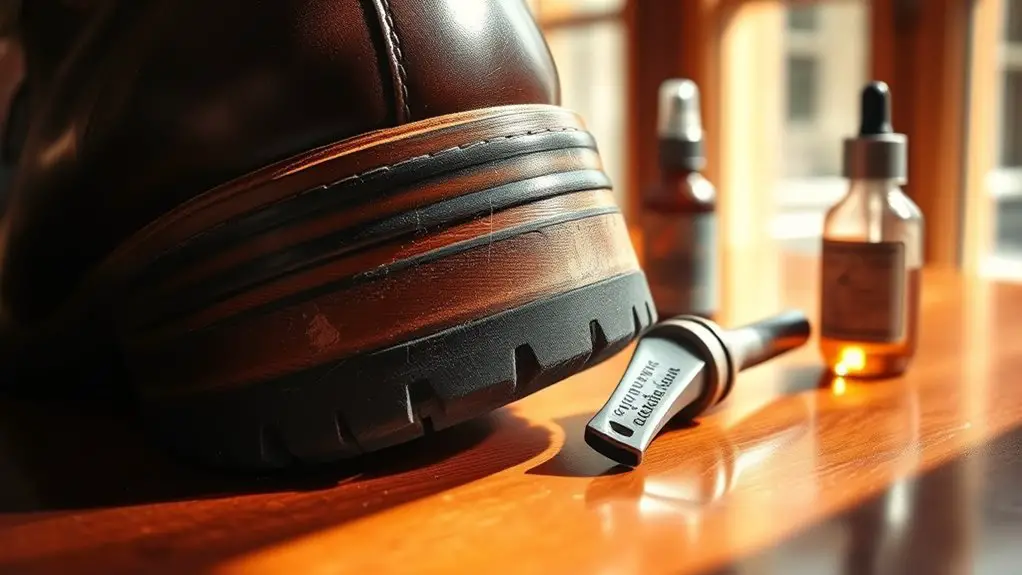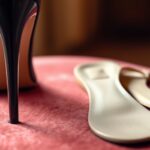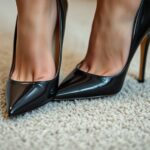To prevent your heel soles from wearing out too quickly, start by choosing shoes that match your lifestyle and provide proper arch support. Regularly maintain and clean your shoes, and consider using heel protectors or inserts for added shock absorption. Mindful walking and analyzing your gait can help identify wear patterns. Also, avoid harsh surfaces and store your shoes properly to enhance longevity. There’s more to explore about shoe care and maintenance techniques to guarantee peak performance.
Understanding the Anatomy of the Heel Sole
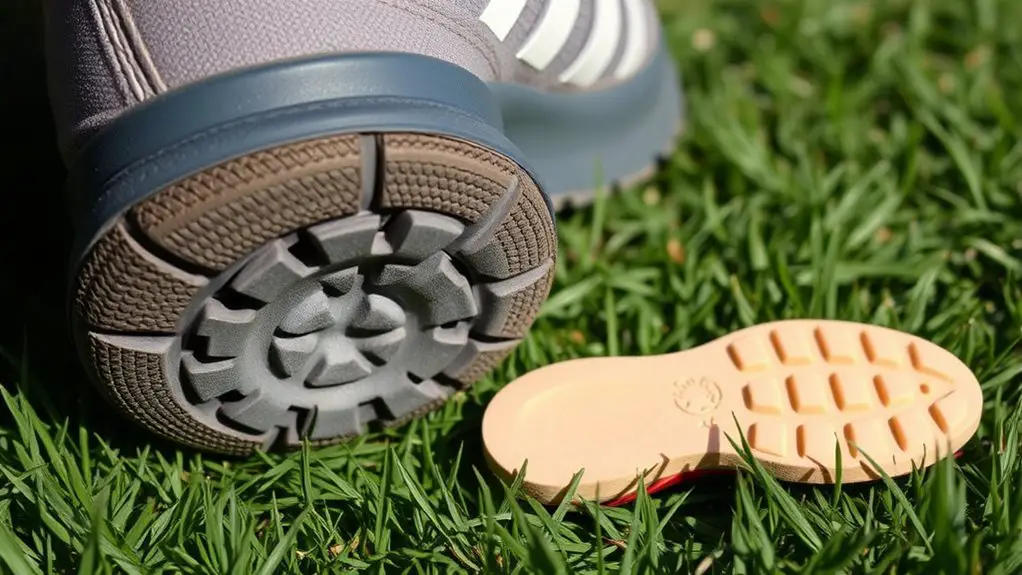
The heel sole is a critical component of footwear, serving both functional and structural purposes. Understanding heel anatomy is essential for appreciating how it impacts the performance and durability of your shoes. The heel consists of several parts: the heel counter, which stabilizes the foot; the midsole, providing cushioning; and the outsole, which makes contact with the ground.
When it comes to sole materials, different options like rubber, EVA, and polyurethane offer varying levels of traction, flexibility, and durability. Rubber outsoles, for instance, are often preferred for their abrasion resistance, while EVA provides lightweight cushioning.
Choosing the Right Shoes for Your Lifestyle
Selecting the right shoes for your lifestyle is essential in preventing heel sole wear and guaranteeing overall foot health. Your daily lifestyle habits, whether you’re frequently walking, running, or standing, dictate the type of shoe materials you should choose. For instance, if you spend a lot of time on hard surfaces, opt for shoes with cushioned soles and durable rubber outsoles to absorb shock and reduce wear.
In contrast, if your activities involve more flexibility and agility, lightweight materials such as mesh or synthetic fibers can provide breathability and comfort while still supporting your heel.
Take into account the fit and arch support as well; poorly fitting shoes can lead to uneven wear on the heel sole. Always assess how the shoes align with your lifestyle habits to guarantee they’ll hold up over time, protecting both the shoe and your feet from unnecessary strain.
Regular Maintenance and Cleaning Techniques
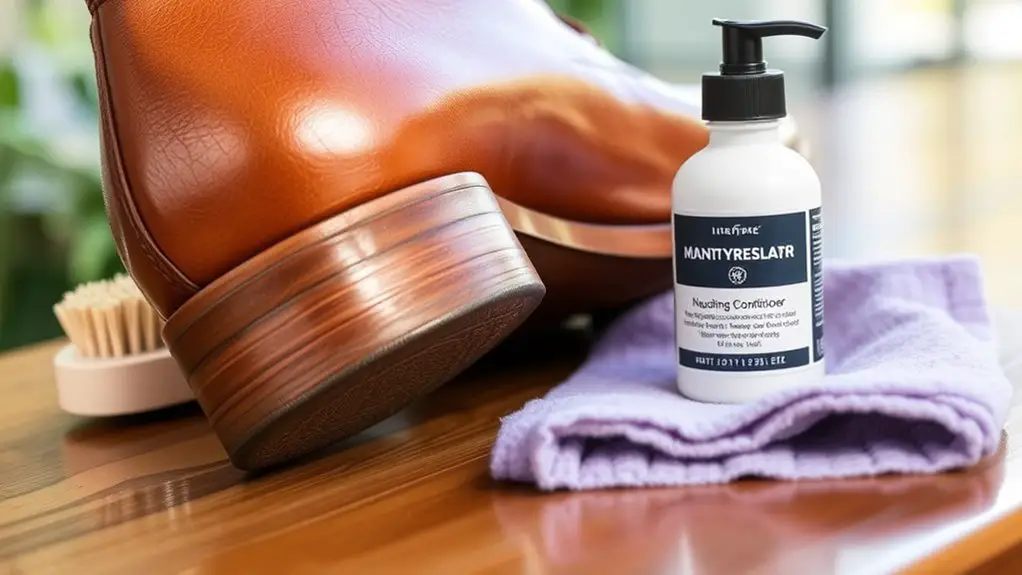
While you may choose the best shoes for your activities, regular maintenance and cleaning are essential for prolonging their lifespan and preventing heel sole wear. Proper shoe care can greatly impact the durability of your footwear. Here are some effective maintenance techniques:
| Maintenance Technique | Recommended Cleaning Products | Frequency |
|---|---|---|
| Brush off dirt | Soft-bristle brush | After each use |
| Wipe with damp cloth | Mild soap solution | Weekly |
| Condition leather | Leather conditioner | Monthly |
| Inspect soles | N/A | Before each use |
| Store properly | Shoe bags or boxes | Daily |
Using Heel Protectors and Inserts
To enhance the longevity of your footwear, using heel protectors and inserts can be an effective strategy. Heel protectors serve as a barrier against wear and tear, often made from durable materials like rubber or silicone. They can be easily applied to the heel area, minimizing friction and prolonging the life of your shoes.
When considering insert types, you have options such as gel, foam, or orthotic inserts. Gel inserts provide cushioning, absorbing shock during impact, while foam inserts offer support and comfort. Orthotic inserts are designed to correct foot alignment, which can also reduce heel sole wear.
Selecting the right heel protectors and inserts based on your activity level and shoe type can make a significant difference. Regularly check the condition of these accessories, replacing them as needed to maintain ideal protection for your footwear.
Mindful Walking and Gait Analysis
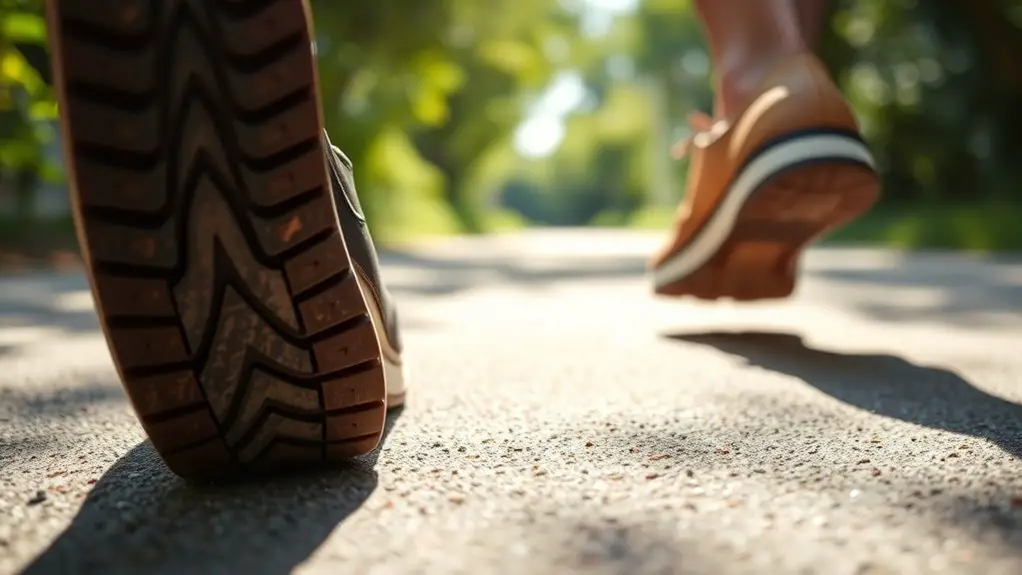
To prevent heel sole wear, it is crucial to select appropriate footwear that matches your foot type and walking environment. Analyzing your walking patterns can reveal underlying issues that contribute to uneven wear. By being mindful of how you walk, you can make necessary adjustments to enhance comfort and prolong the life of your soles.
Proper Footwear Selection
Selecting the right footwear is essential for minimizing heel sole wear, as it directly influences your walking mechanics. Different foot types—such as flat, neutral, or high-arched—require specific support to maintain proper alignment. When choosing shoes, consider the material quality; high-quality materials provide better cushioning and durability, which can greatly extend the life of your heel sole. Make sure the shoe fits well, allowing for natural movement while preventing excessive friction. Look for features like arch support and shock absorption, tailored to your foot type, to enhance stability and comfort. Remember, investing in appropriate footwear not only protects your heels but also contributes to overall foot health and reduces the risk of injuries.
Analyzing Walking Patterns
Even with the right footwear, understanding your walking patterns can greatly impact heel sole wear. Conducting a gait assessment allows you to identify abnormalities in your foot biomechanics that may lead to uneven wear. By carefully analyzing how your feet strike the ground, you can determine if you overpronate, underpronate, or have a neutral gait. Each of these patterns affects how force is distributed along the sole of your shoe. Mindful walking can help you adjust your stride and posture, promoting a more efficient gait cycle. This awareness can lead to improved foot mechanics, ultimately extending the lifespan of your footwear. By integrating gait analysis into your routine, you can proactively prevent premature heel sole wear.
Avoiding Harsh Surfaces and Conditions
To minimize heel sole wear, you should prioritize soft walking paths whenever possible. Hard surfaces can accelerate deterioration, so look for grass or dirt trails instead. Additionally, limiting exposure to wet conditions can prevent material degradation and enhance the longevity of your footwear.
Choose Soft Walking Paths
While you might not think about it often, the surfaces you walk on can greatly impact the longevity of your heel soles. Choosing soft terrain over harsh surfaces is essential for reducing wear. Opt for scenic routes that feature grass, dirt, or gravel paths instead of concrete or asphalt. These softer materials absorb shock, lessening the strain on your footwear and extending the life of your heel soles. Additionally, uneven surfaces like trails can provide a natural cushion, minimizing impact. By consciously selecting these gentler walking paths, you not only enhance your comfort but also protect your investment in quality shoes. Remember, the right path can make all the difference in preventing premature heel sole wear.
Limit Exposure to Wetness
If you want to extend the life of your heel soles, limiting exposure to wet conditions is essential. Wet surfaces can cause considerable wear, leading to premature deterioration. Opt for footwear made from water resistant materials, which can fend off moisture and protect your soles. Additionally, consider using moisture absorbing insoles, as they help keep your feet dry and reduce the chance of water seeping into the shoe structure. Avoid walking through puddles or on wet grass, as these conditions can accelerate wear on your heel soles. If unavoidable, try to dry your shoes promptly after exposure to moisture. By taking these precautions, you can considerably prolong the lifespan of your heel soles and maintain their performance.
Periodic Professional Repairs and Resole
Although regular maintenance can extend the life of your shoes, periodic professional repairs and resoles are essential for addressing significant wear and tear. Engaging professional services guarantees that your footwear receives the best care, utilizing advanced resole techniques tailored to your shoe type.
| Repair Type | Description |
|---|---|
| Full Resole | Complete replacement of the sole. |
| Half Resole | Replacement of only the worn area. |
| Stitching Repair | Fixing seams and uppers. |
| Heel Replacement | Changing out the heel unit. |
Storing Your Shoes Properly for Longevity
Proper shoe storage is vital for maintaining their condition and extending their lifespan. To achieve effective shoe organization, keep your footwear in a cool, dry place away from direct sunlight. Excessive heat and moisture can deteriorate materials and lead to deformities. Utilize shoe boxes or racks to prevent them from getting squished, which can also affect their shape and comfort.
Temperature control is important; ideally, store your shoes in an environment between 60-75°F (15-24°C). This range minimizes the risk of material breakdown. Consider using silica gel packets in your storage area to absorb excess moisture.
Regularly checking on your shoes can also help catch any potential issues early. By implementing these practices, you’ll not only keep your shoes looking their best but also prolong the life of the heel sole, preventing premature wear and ensuring peak performance when you wear them.
Frequently Asked Questions
How Often Should I Replace My Shoes to Prevent Heel Wear?
Think of your shoes like a car; regular maintenance is key. Typically, replace them every 300-500 miles or when you notice replacement signs, like worn-out soles. This guarantees ideal shoe lifespan and comfort for your feet.
Can Heel Wear Indicate a Specific Walking Issue or Foot Problem?
Yes, heel wear can indicate specific walking issues or foot problems. A gait analysis can reveal abnormalities in foot mechanics, helping you identify factors contributing to uneven wear and allowing for potential corrective measures.
What Materials Are Most Durable for Heel Soles?
When considering durability for heel soles, rubber soles offer excellent shock absorption and wear resistance, while leather soles provide breathability and elegance. Selecting the right material can greatly enhance your footwear’s longevity and performance.
Do Certain Shoe Brands Have Better Heel Durability Than Others?
Certain shoe brands do exhibit better heel durability than others. By conducting brand comparisons and reading customer reviews, you can identify which brands consistently deliver higher quality materials and construction, ultimately leading to longer-lasting heel performance.
How Can Weather Conditions Affect the Longevity of My Shoes?
Weather conditions greatly impact shoe longevity. Rainy conditions can cause materials to weaken, while temperature extremes may lead to cracking or warping. Proper care and storage in varied climates can help extend your shoes’ lifespan.

